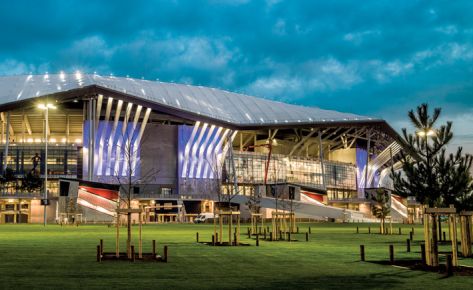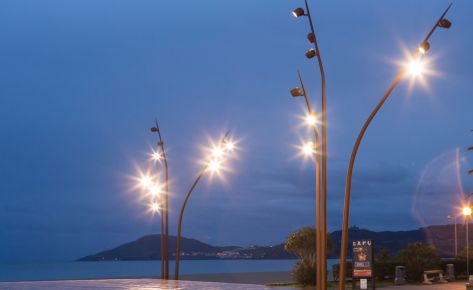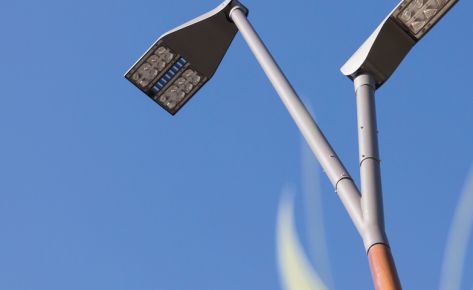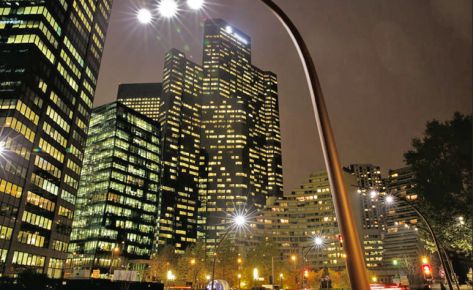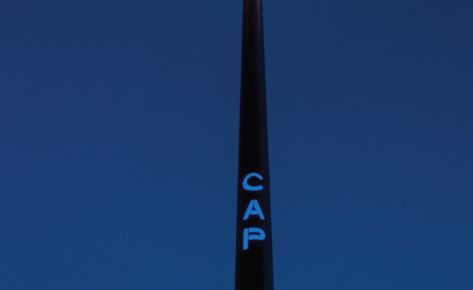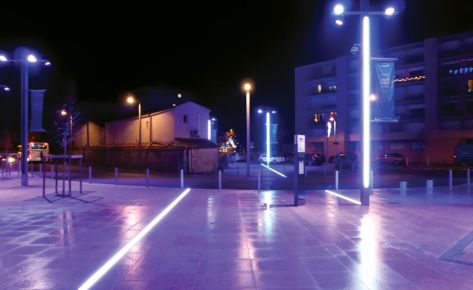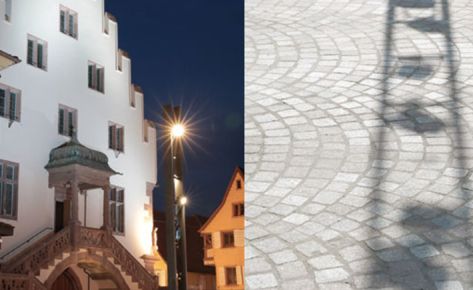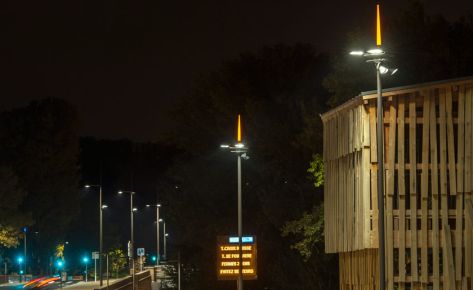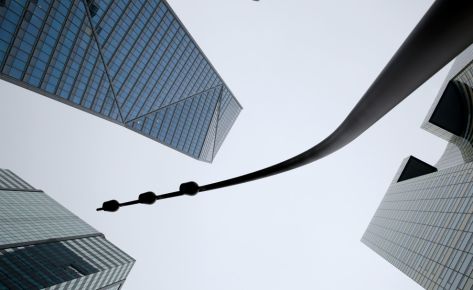High yield strength steels are steels with “spring” characteristics under stress.
They should be used with caution, as their characteristics are not conducive to fatigue strength.
Devices to restrain an operator when working and climbing the mast, system coupled with a harness.
Metal part installed at the bottom of the mast, opposite the door, to secure the electrical box. Note that this element differs from country to country.
DIN rail mounting is also possible, with the box installed in the space designated and dimensioned as a CF “inscribed square”.
Element used to ensure earth continuity and connect the mast to it.
Masts with a tilting joint that allows access to the lantern for maintenance without the need for a ladder or gondola.
CO² emissions for the manufacture of a mast.
Metal part installed when the mast is erected to prevent the cable from flying away.
Plastic or steel element, when it’s not decorative, which obstructs the top of the mast to prevent birds from getting inside (with no way of getting out) and to avoid the penetration of rain and insect nests.
Cable installed between the door and the mast, to hold the door in the open position when the top hinge is hidden.
Pole used to install a public lighting system.
Plastic plugs filled with grease for installation on the nuts mounted on the sealing rods to prevent corrosion, they will allow easy dismantling, these elements protect the threads from the cement or coating that will be laid at the foot of the masts.
Space available in front of the door to install the electrical box.
This inscribed square is linked to the conicity of the mast and the height of the door.
Care must therefore be taken with double doors, as the higher one will offer a smaller inscribed square.
Poles linked by a cable.
Lanterns, decorations or shading elements will be installed on this cable.
This marking is compulsory to be able to market lighting elements in the public domain.
It is the visible sign of product compliance with the requirements of European directives on construction products.
Certification is issued by independent bodies appointed by members.
A mechanical linkage makes the door integral with the mast to avoid mixing doors and losses.
Rolls of sheet metal of different widths and specific steel grades, uncoiled and cut into trapezoids, form the basis for the mast.
Value indicating the reduction in diameter of a mast per metre.
The formula (base in mm- head in mm )/ height in m
Example: base 130mm- head 60mm/5 taper 14mm i.e. (130-60)/5= 14 mm/m
Offset element for installation of the lantern, this element is screwed onto the body of the mast, so it is necessary to indicate its orientation in relation to the door. The product is also used for wall mounting.
Series of 8 screws installed in two rows at the top of the mast to lock the elements installed at the top of the mast in rotation, standard spacing 120 and 220 from the top of the mast.
This element is installed at the top of the mast, and is locked in rotation by means of screws.
Lettering, shapes and city coats-of-arms are cut into the mast body.
Often equipped with backlighting, they are used for signage or beaconing.
The mast is calculated according to the cut-outs to ensure its mechanical strength and compliance with standards.
A welded half-mesh is a steel fastening point made up of a half-ring of steel, used as a pick-up point for a cable, for example.
Offset or protrusion, length of offset of the lantern in relation to the shaft of the mast, in the case of the bracket, or to the axis of the mast, in the case of the crook.
Total weight and stresses applied to the mast + a safety factor of 1.2.
The diameters and surfaces of the rods are calibrated to ensure a firm hold in the bedrock and to resist stress.
It is essential to follow the models and instructions given in the catalog.
Elements protruding from the body of the mast at regular intervals to allow access to the top.
Protective coating applied at the base of the exterior mast and, if necessary, on the inside to provide additional corrosion protection.
The base of the mast is replaced by a stainless steel plate, which is welded to the end of the trapezoid that will form the mast, before the assembly is folded; this addition is invisible and creates no fragile zones.
This stainless steel part protects the mast base against corrosion in areas subjected to sandblasting, contact and spraying with corrosive elements such as salt water or road salt.
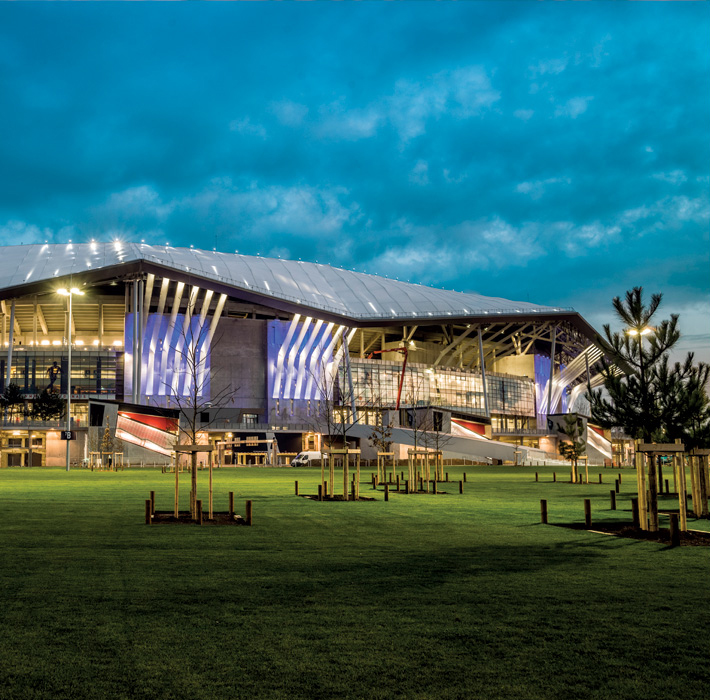
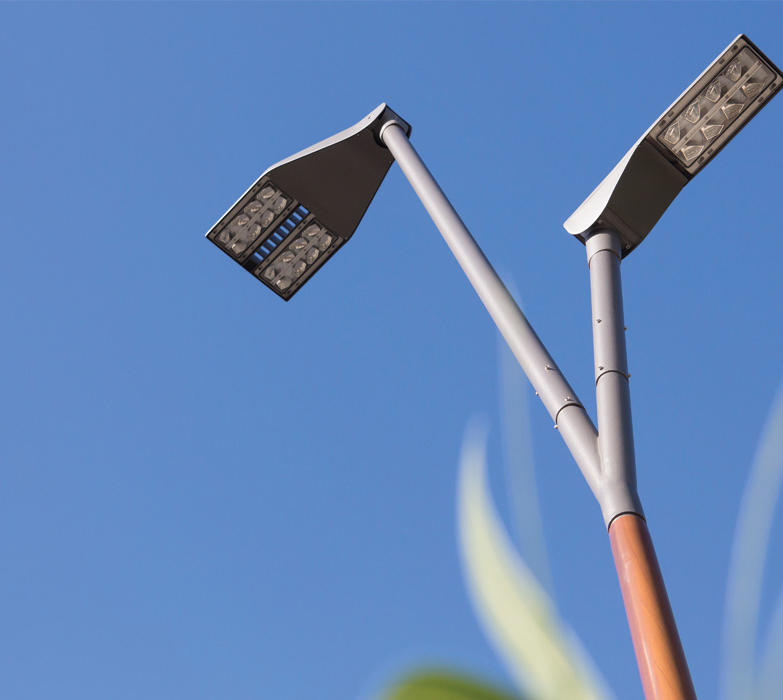

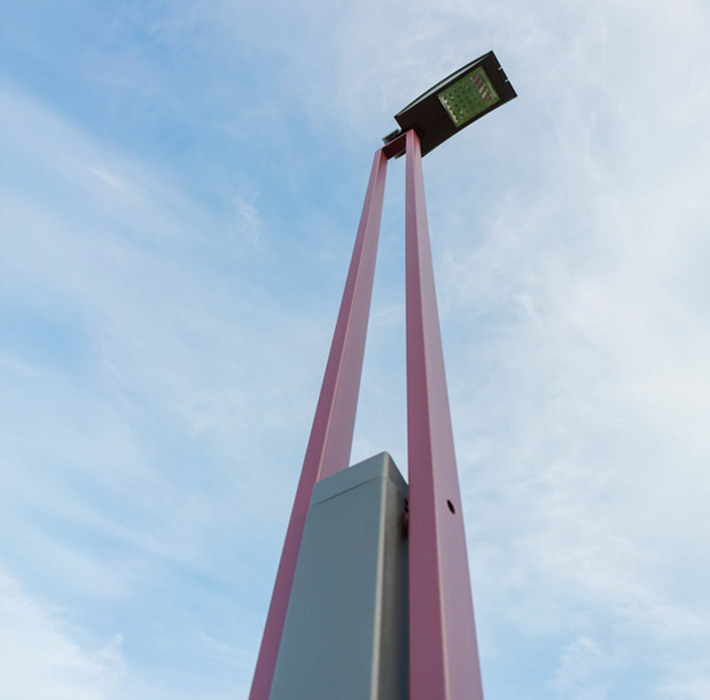
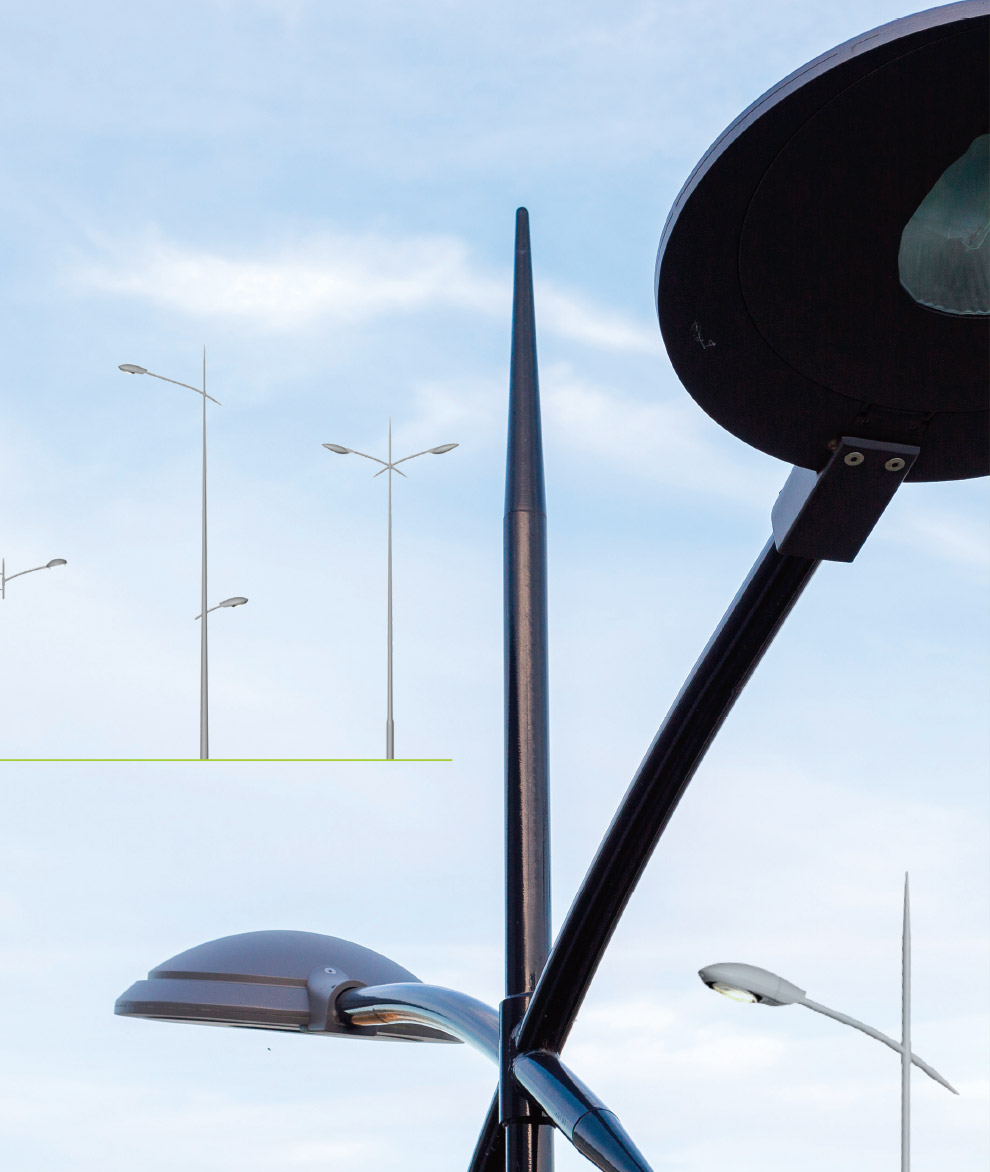

Decorative element installed at the top of the mast, often in painted or illuminated aluminum.
It can be used to install a component designed for a given diameter and standardized on another diameter 60 62 76 89 102 114 …
Mandatory standard for mast design.
This standard ensures the safety of users in the vicinity of lighting masts and their resistance to wind, depending on the lighting, lantern offset, decorative and signage elements installed on the mast.
Center-to-center distance term used for footings, where the center-to-center distance between rods is measured from the periphery.
The living environment of a construction or mast is classified according to its corrosivity, from C1, the least corrosive, to C5M or beyond.
Asking for C5 protection doesn’t correspond to any reality: the other essential parameter for defining protection is the expected longevity and maintenance that will be carried out on the product.
For example, a product designed to last 10 years in C1 without maintenance will only last 1 or 2 years in C5M.
Before painting or delivery, the masts are hot-dip galvanized.
The silicon and phosphorus content of the steels used will determine the thickness of the galvanizing.
The standard governing these thicknesses is EN 1461, for 3mm, the required thickness is 55µm, with an average thickness of 65µm.
The masts oscillate under the effect of the wind and the weight they support, which causes fatigue in the metal structure. Conimast masts are designed to provide 25 years of mechanical service if corrosion has not attacked the structure.
Steel edging added around the door to provide an additional seal or prevent the intrusion of foreign bodies, has no mechanical addition.
Mast tilt under one or more lateral stresses.
Metal or textile part that yields to a certain traction to indicate that the maximum tension has been reached.
By extension, the body of the mast, whether cylindrical, octagonal or other.
To help you position the mast anchoring rods precisely, you can order anchoring templates. These are drilled identically to the mast base, ensuring precise positioning.
The process of quenching a steel part in a bath of molten zinc at 450°. This anti-corrosion process creates iron-zinc bonds, making the protected part highly resistant to corrosion and scratching.
Height of light point under glass.
Height of the mast assembly plus the thickness of the deep-drawn base plate for 200mm centers, which is 30mm, and 50mm for base plates with 300mm centers.
Height from top of sole to bottom of door.
Lifting and positioning method used for stadium masts.
This very rapid procedure requires a few precautions.
It must therefore be indicated in the request.
Harrow to prevent mast climbing and access to masthead equipment.
A whitish powder and natural paste created by zinc’s reaction to corrosion. This water-insoluble layer protects the zinc from further aggression.
Angle added in relation to the horizontal that will affect the lantern’s inclination.
Masthead or top-mounted lighting installed in line with the mast, taking into account the diameter of the masthead and the overlapping or interlocking lantern system.
Lantern whose base covers the mounting tube installed on the mast.
Mandatory and binding marking of mast manufacturing and calculation processes.
Cast concrete block in which the anchoring rods are embedded. Its dimensional characteristics are given for information only.
They can be found in the catalog or in the technical section of the 2 bar underground masts.
Concrete blocks fitted with standard-sized rods ensure the stability of the mast, a method increasingly used for its rapid installation.
The standard conical mast can be octagonal, circular or hexagonal.
Conical mast with a circular cross-section tapering steadily from the base to the standard head diameter (see taper).
To obtain sufficient heights from 15m upwards, the masts are made in two parts: the upper part caps the base, and the weight and interlocking ensure the cohesion of the whole. The interlocking calculation is at least 1.5 the diameter of the base.
A mast made up of several elements: a base element supporting the door, which can be the lower part of a mast, and a welded ring linking it to a tube ensuring the mast’s overall height.
Octagonal mast with 8 sides, from the base the cross-section reduces steadily to the standardized diameter of the head (see taper).
Mast made from commercial square-cylindrical profiled tube.
The masts are straight as standard, but can be bent to obtain a stylish effect and original alignments. The steel used for the masts has limited elastic or plastic limits.
Bending radii are therefore limited to accentuate the visual aspect, and it is possible to combine bending with tilting.
The foot of the mast is cut at an angle to the vertical – this option can be combined with bending (see bent mast).
Bending is the deformation of an element or assembly under the action of a stress or load, which results in bending.
It’s a force exerted in the form of wind rotation on the lanterns installed at the end of a stock, and it’s also the transmission of forces to the supports and therefore to the footings and fixing rods.
A metal or plastic part that obstructs the masthead to prevent birds from entering the mast body and getting lost.
The position of holes for brackets or sockets is given by the height above the flange and the orientation in degrees to the right or left in relation to the door axis. Without this information, the position of the hole is impossible.
Intimately linked to resistance calculations, if by default calculated at 45° to the orientation of the light point in the case of a bracket or bracket, this must be taken into account during installation.
“CE marking of lighting columns:
On the product: simplified marking.
A label on the product showing the manufacturer’s name, CE mark and notifié organization number.
A stamped marking on the inside of the mast with the manufacturer’s initial, article code, manufacturing order and year of manufacture.
On the associated commercial document: the full marking required by the standard.
General information (manufacturer, notifié organization, etc.).
For each item, the certificat number of the corresponding range and its conventional declared surface area.
This conventional (admissible) surface area is the result of a calculation carried out in accordance with the conditions definies in the implementing regulations for the CE certificate of conformity: V = 24m/s, load class B, terrain category II, weight of each lantern 15 kg, deflexion class 3, impact resistance class 0.
Note: The declared value is conventional and does not take into account actual conditions of use.”
If there is a rung to climb the mast every 6m, a resting landing must be installed to facilitate the passage of the operator.
Space available to run the cable up to the power supply box.
On a flat base, it corresponds to the diameter of the mast foot on a 200mm deep-drawn base, 82mm clearance on a 300mm deep-drawn base, 130mm cable clearance on buried masts, a 50mm/150mm oblong is punched.
Part used to attach a bracket to a mast, two types are available U-shaped (offset from the shaft) or flat curved to fit the shape of the shaft.
Two-coat epoxy-polyester application process that fuses to form a waterproof, protective system suitable for C5 environments (see corrosivity classes).
The same application process as for polyester paint (see this term), epoxy paint offers excellent waterproofing, better than polyester, but poor UV resistance, so we combine the advantages of these two types of paint to create paints for aggressive environments such as the seaside.
a layer of epoxy gelled at 120°C, then polyester powder-coated and fully polymerized at 180°C.
Liquid paint applied to masts, less and less used for ecological reasons, a lot of waste when sprayed on, desolvation is done in the open air, which is industrially restrictive, this process allows for repainting campaigns, application is then done with a roller, the appearance is degraded.
Commonly referred to as powder coating.
It’s a very fine, tinted polyester powder that clings to the product to be painted (after surface preparation) to cover it evenly, and is then “oven-baked” at 180°c to cross-link (melt and fuse) to form a uniform, protective plastic film (polyester).
polyester offers excellent UV resistance
Cf. polyester epoxy paint
Hard rubber compression elements to slightly adjust mast verticality (often used when it’s not possible to fit an adjusting nut under the base).
To install a bracket on the mast shaft, you must indicate the orientation in relation to the door.
The drilling consists of a hole for the cable and two inserts for screwing the console in place.
Plate usually affixed by the installer or dealer.
This plate is used to identify a luminous point for monitoring and maintenance purposes.
Installed at the top of tall masts, it enables floodlights to be maintained. The advent of LED lighting, which offers longer service life, has led us to opt for gondola maintenance.
As a result, masts are larger and therefore less expensive.
A mast whose body is made up of several regular faces. The octagonal mast cf. (this term) is a special case.
see overlay door
Part perpendicular to the body of the mast, allowing the installation of pennants. The surface must be taken into account when calculating the strength of the mast.
Particular attention must be paid to traffic flow and therefore to the height of this element.
Replacement door in thin steel, conformable to the shape of the shaft. Specify the type of mast when ordering, or at least the size of the door.
Louvered perforation on the door for mast ventilation, useful for electronic elements with risk of overheating, installed to control light fittings.
Note that the upper part of the mast must also be ventilated.
Welded to the mast visible on baseplate masts at the base of DIN-rail masts
Surface-mounted socket for powering illuminated decorations.
Metal tube element installed around the mast to prevent impact by machinery or vehicles.
Spiral plastic element that protects the mast foot during the installation of coatings or the passage of rotofilaments.
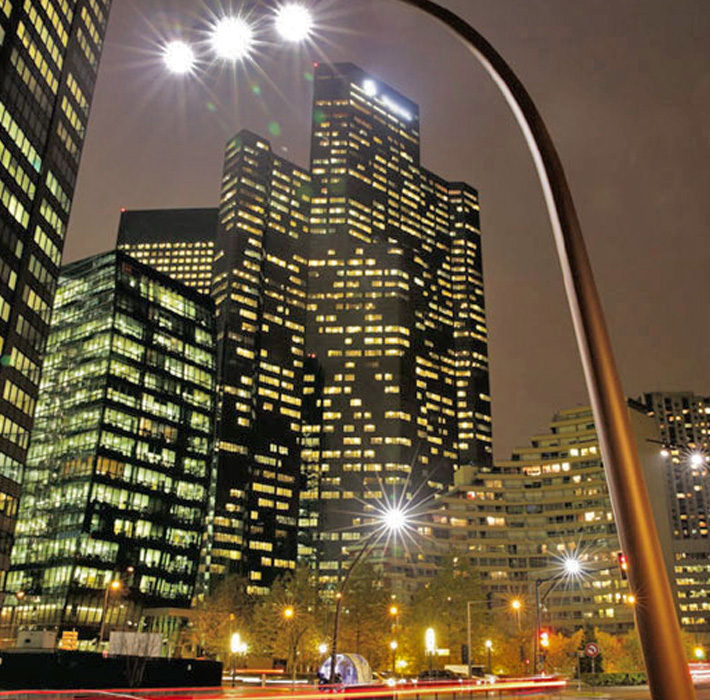

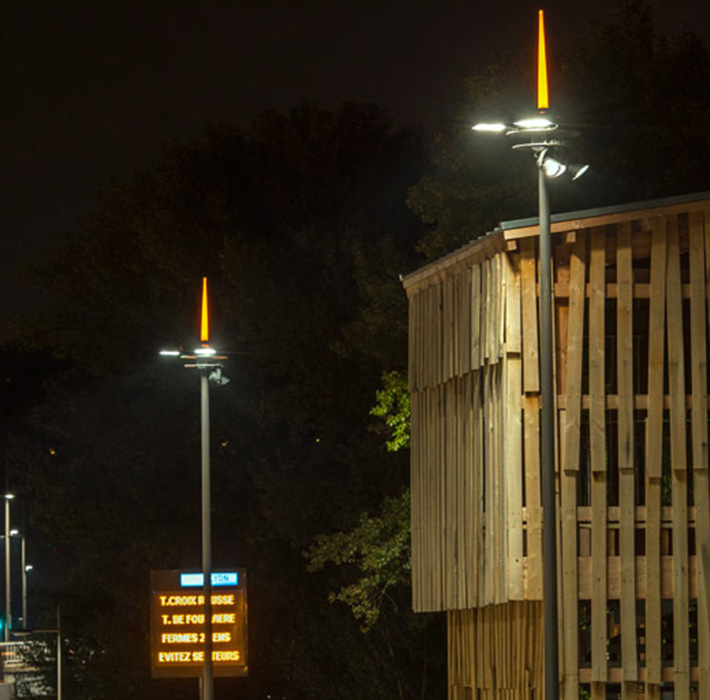
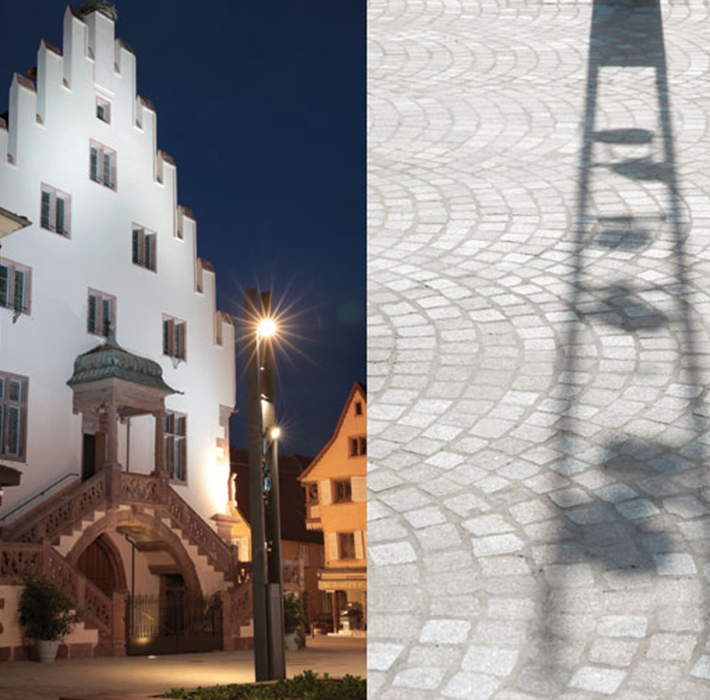
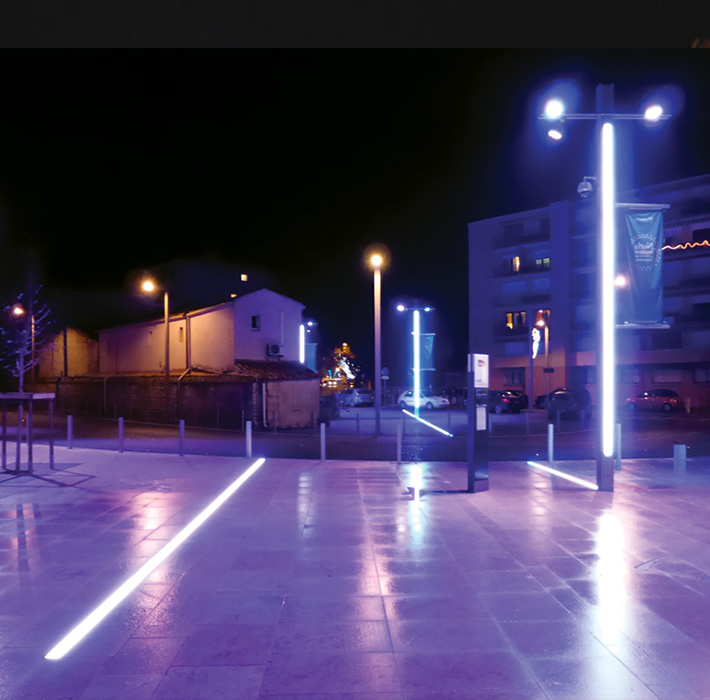
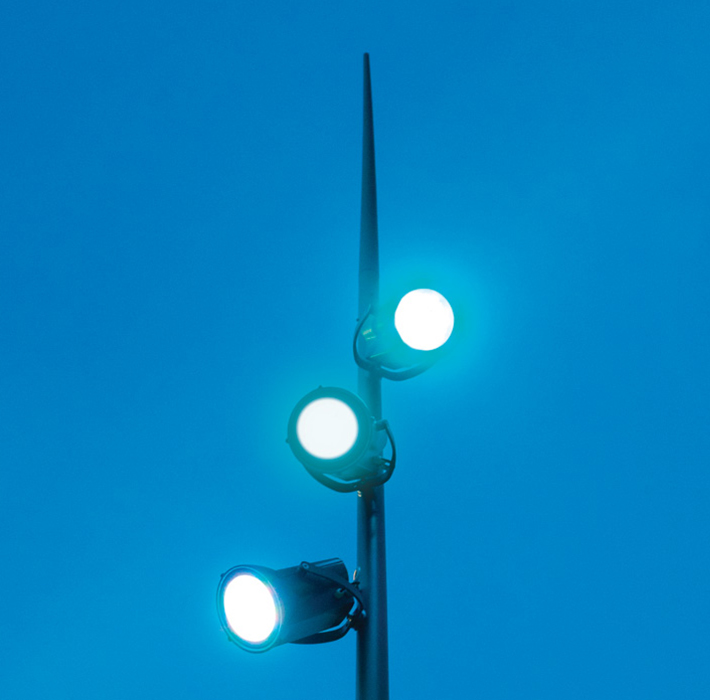
Welding Procedure Qualification Samples are welded in front of an inspector following the usual procedure and sent to an independent laboratory for a battery of macroscopic penetration tests.
Rail positioned in front of the door to secure the electrical box for countries using this system.
It’s a color standardized by paint manufacturers, so it’s similar and ensures that there are no color differences between them.
So even with different sources of supply, the mast, stock and lantern will have a uniform appearance.
The additional height given by an element installed at the top of the mast (top of mast) will modify the height under the lantern, so it is sometimes necessary to take this into account when planning illuminance.
Additional height gained by an element installed at the top of the mast (top of mast) this height will modify the height under the lantern, so it may have to be taken into account when planning illuminance.
Parallel steel plate installed parallel to the inscribed square, without encroaching on it, to stiffen the mast and substantially cancel out the door in the mast strength calculation.
A mast that is thermally and mechanically deformed to create one or more shapes on the shaft.
A mechanical element that can be adjusted to give the right inclination to a lantern fixed under a stock or bracket, often fitted with a threaded end to match the gas pitch.
Quality of the steels used to manufacture the masts the mechanical characteristics of these steels are used for strength and fatigue calculations.
The offset length imposed by an add-on element in relation to the mast axis.
This projection will offset the lantern from the mast axis by the specified length.
Part used to attach a bracket to a mast, two types are available U-shaped (offset from the shaft) or flat curved to fit the shape of the shaft.
Calculation basis for estimating emissions from the well to the delivery of the product over its entire value chain. For a mast, the steel used is by far the essential part.
Frontal surface offered by a lantern and possibly its bracket or console. This element, together with the weight, among others, enables us to calculate the forces and thus determine the geometry of the mast that will serve as support.
An alternative to the more costly stamped base plate, it is used when the mast’s strength calculations require it, particularly for fatigue strength. It offers the advantage of full passage at the foot of the mast, with the base of the shaft embedded in the base plate, and a double weld between the shaft and base plate, one on the outside and one on the inside.
used when mounting centers exceed 300mm.
Deep-drawn sole or tulip sole, each manufacturer has its own morphology and pressing tools.
The more or less elaborate shape and the thickness of the steel will influence the strength of the assembly.
Standard center-to-center distances 200 mm and 300 mm, distance to center of fixing rods 4 measurements.
Lock equipped with a screw with a specific imprint preventing easy opening with a standard tool if with 3 ergos magnetic screw type “cism” which turns endlessly without the right magnetic key, electric strike…Different systems are on the market.
Welded along the length of the mast, it ensures cohesion on multi-shell masts or the closure of “C” masts, and is essential for mast strength.
A painting process that reproduces the grain of wood or a particular texture, such as that of a concrete mast.
Flat fixed to the body of the mast to allow safe placement of a ladder and eliminate the risk of rotation
The catalog includes load tables for loads, scx, wind zones and terrain categories.
These values must not be exceeded, otherwise the mast’s service life may be shortened or destroyed.
The installer is responsible for exceeding these values without the manufacturer’s knowledge and agreement.
It’s a color that belongs to a paint manufacturer, with its own formulation, so it’s difficult to countertype.
Note that the eye is an excellent comparator: a few points of difference, a slight dominance, will be immediately identified. Lighting products are outdoors and often observed from several meters away, which can allow a certain tolerance.
Paint contains agents that act on the polymerization of the powder, modifying the appearance of the material – paint, crackling, roughness, relief, etc. There are many different effects.
Diameter of end of top or top mast
Commercial or custom-designed profile installed at the top of the mast or by flange(s).
Metal used to protect masts against corrosion.
Through a sacrificial process, zinc, which forms a white hydroxide layer on contact with humidity, protects the steel it surrounds.
Fusion layers between steel and zinc make it highly resistant to scratching and abrasion.
This data is essential for calculating the mast with the scx (see this term), the lantern and possibly the stock.
Each location will be subject to the usual prevailing winds, expressed in m/s. On this site, you’ll find the wind zone for each zip code and the zones for the various countries where we sell. Some countries not subject to EN40 also take account of snow or frost depth.
